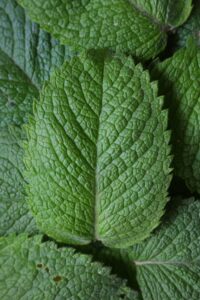 Mentha piperita (peppermint) oil*
Mentha piperita (peppermint) oil*
Peppermint is sometimes regarded as the world s oldest medicine, with archaeological evidence placing its use at least as far back as ten thousand years ago.
It has a high menthol content, and is often used as a flavouring in tea, ice cream, confectionery, chewing gum, and toothpaste. The oil also contains menthone and menthyl esters. It is the oldest and most popular flavour of mint-flavoured confectionery. Peppermint can also be found in shampoos and soaps, which give the hair a minty scent and produce a cooling sensation on the skin.
Peppermint Oil is recommended for the following conditions: Acne, Aerophagy, Arthritis, Bites – Insect, Blackheads, Bloating – Dispel Gas, Bronchitis, Bronchitis – Chronic, Bruises, Candida Albicans, Canker Sores, Catarrh, Cold Sores – Topical For Pain, Concentration – Lacking, Constipation, Cysts, Dandruff, Dermatitis, Diabetes, Diarrhea – With Gas, Digestion – Sluggish, Digestive Problems, Dizziness, Dysentery, Dyspepsia, Fainting, Fatigue, Fevers, Flu – Relieve Nausea, Gas – Fast Relief, Gastritis, Headaches, Hysteria, Impetigo, Impotence, Infection – Skin, Inflammation, Irritable Bowel Syndrome, Jaundice, Liver Problems, Lumbago, Lymph Fluid Drainage, Menstruation – Scanty, Mental Fatigue, Morning Sickness, Mumps, Myalgia, Nervous Disorders, Neuralgia, Pain – Joints, Pain – Muscles, Parasites – Intestinal, Pimples, Poisoning – Gastro-intestinal, Pruritis, Rheumatic Fever, Rheumatism, Ringworm, Skin – Itching, Skin – Oily, Skin – Swollen, Skin – Tired, Sore Muscles, Spasm – Gastric, Stomach Ache, Sunburn, Tension, Tremors, Ulcers, Vomiting – Nervous and Weakness.
The Plant – Mentha Piperita
The plant is indigenous in Europe and now widespread in cultivation throughout all regions of the world.
It is a herbaceous rhizomatous perennial plant growing to 30–90 cm (12–35 in) tall, with smooth stems, square in cross section.
The rhizomes are wide-spreading, fleshy, and bare fibrous roots. The leaves are from 4–9 cm (1.6–3.5 in) long and 1.5–4 cm (0.59–1.6 in) cm broad, dark green with reddish veins, and with an acute apex and coarsely toothed margins. The leaves and stems are usually slightly hairy.
The flowers are purple, 6–8 mm (0.24–0.31 in) long, with a four-lobed corolla about 5 mm (0.20 in) diameter; they are produced in whorls (verticillasters) around the stem, forming thick, blunt spikes. Flowering is from mid to late summer. The chromosome number is variable, with 2n counts of 66, 72, 84, and 120 recorded.





